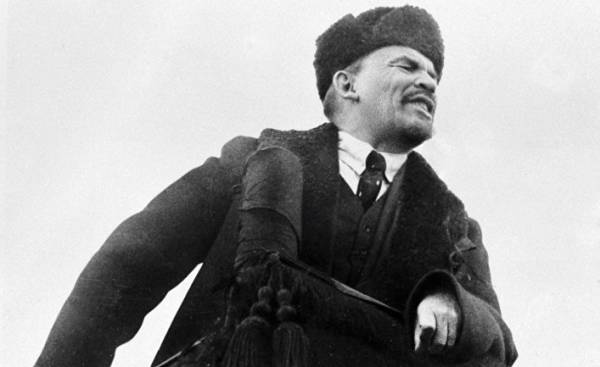
Oxford, England — “Hurrah! Yay! Hurrah!” I vividly remember the wall of sound, which the soldiers in the gray uniform, and with stern faces met greeting his commander: “I Congratulate you on the 70th anniversary of the great October socialist revolution!”
On that cool November day in 1987 when I was an exchange student, I went on Gorky street in Moscow to watch a military parade, moving to red square. On the area of Soviet and foreign statesmen watched as the young soldiers paid tribute to the leader of the world proletariat. It is an impressive sight was to serve as a clear demonstration of the enduring revolutionary power of communism and its global reach.
Soviet leader Mikhail Gorbachev made a speech, dedicated to the movement, based on the values of 1917, before an audience of left-wing leaders, among whom were Oliver Tambo (Oliver Tambo) of the African national Congress and Yasser Arafat (Yasir Arafat), head of the Palestine liberation Organization. The square also had a lot of banners with the words of the Russian poet Vladimir Mayakovsky: “Lenin lived, Lenin lives, Lenin will live.”
However, at the time this slogan has sounded out of tune, because the economic problems the USSR was obvious to all, especially to my Russian fellow students, whose livelihood depended directly on their poorly-funded universities. But despite all this, the Soviet system seemed to be as strong as the marble of the mausoleum of Lenin. Like many observers, then I never would have believed that just two years communism will hand over their positions, and that in four years the Soviet Union will collapse.
Very soon the public perception of the events of 1917 has changed radically: free markets began to seem something quite natural and inevitable, and communism became a phenomenon which was doomed to, as Leon Trotsky said to be in “the dustbin of history.” Perhaps the global liberal order will face any challenges and threats, but now they will have to come from Islam or the state capitalism of China, instead of from discredited Marxism.
Today, as we celebrate the 100 year anniversary of the February revolution, which became a prequel to the November uprising, the Bolsheviks of Lenin, the story again changed the direction of its movement. China and Russia have used the symbols of its Communist heritage, to strengthen the position of anti-liberal nationalism. In the West faith in free markets has not recovered after the financial crisis of 2008, but the new forces of the far-right and the ultraleft-wing parties are rapidly gaining popularity. Unexpectedly strong position of the independent socialist Bernie Sanders (Bernie Sanders) in last year’s fight within the Democratic party in the United States and the success in the Spanish elections a new party Podemos, led by former Communist, are signs of strengthening of the positions of the left among the masses. In 2015, the classic work of Marx and Engels “the Communist Manifesto” became a bestseller in the UK.
Now, I ask myself whether you really saw that day in Moscow “last hurrah” of communism. Or, perhaps, at the moment we are witnessing the birth of a new version of communism, appropriate for the twenty-first century?
Perhaps we should look for clues in this challenging and almost a century of history, full of false starts, moments when collapse seemed inevitable, and unexpected revivals.
Consider the life of Seeds Kanatchikov. Being the son of a former serf, he left his impoverished village to the city to work in the factory and to feel the trends of our time. Energetic and sociable of Kanatchikov decided to improve, using the tutorial of dancing and good manners as a guide. Immediately after his arrival in Moscow, he joined the socialist discussion club, and later the Bolshevik party.
 © RIA Novosti RIA Novosti | go to photobacteria I-th anniversary of the great October revolution
© RIA Novosti RIA Novosti | go to photobacteria I-th anniversary of the great October revolution
Experience Kanatchikov made him susceptible to revolutionary ideas: his eyes saw a huge gap between rich and poor, he felt that the old order prevents the birth of a new, and he could not accept discretionary authority. The Communists have proposed a concrete and compelling solutions. Unlike the liberals, they advocated economic equality, unlike the anarchists they recognized modern industry and government planning, in contrast to the moderate socialists, they argued that change must happen through the revolutionary class struggle.
In practice, these ideals, it is quite difficult to combine. Omnipotent government sought to contain the growth, strengthening the position of the new elite, and the revolution brought periodic bouts of hunting for “enemies”. Kanatchikov became one of the victims of this hunting. After the revolution, its connection with the main enemy of Stalin, Leon Trotsky, led to a decrease it to the post in 1926.
By the time the prospects of communism already looked pretty grim. First outbreak of revolution in Central Europe after the First world war has already been redeemed. The USSR was isolated, and the Communist parties in other countries were weak and often marginalized. The American “roaring twenties” in nature was unceremoniously consumerist, not a Communist.
The shortcomings of the policy of state interference in the economy very soon came to communism for help. The collapse of wall Street and the ensuing Great depression turned the socialist idea of equality and state planning in a compelling alternative to the invisible hand of the market. The militancy of communism also made him one of the few political forces are ready to counter the threat of fascism.
Even the US, which never was prone to atheistic collectivism and socialism, turned into fertile land. When in 1935, Moscow abandoned the doctrine in favor of a policy of supporting “popular fronts”, the American Communists merged with the moderate left against fascism. Al Richmond (Al Richmond), new York journalist of the newspaper the Daily Worker, talked about a new wave of optimism that gripped him and his colleagues when in an Italian restaurant they propose a toast to “life for what it is, for that age, for its wonders and hopes for the rhythm of this time because it hears the beat of our hearts.”
This optimism was shared by only members of a certain group of favorites. A victim of Stalin’s purges, Simon of Kanatchikov died in the Gulag in 1940.
Many were ready to close eyes to the Stalinist terror for the sake of anti-fascist unity. However, a second wave of communism in the late 1930’s and early 1940’s, did not last long after the defeat of fascism. The growth of the intensity of the cold war, the identification of communism with the Soviet Empire in Eastern Europe allowed him to claim the status of a liberator. In Western Europe reformed and regulated capitalism, with U.S. support, became the basis for the growth of living standards and the creation of States with developed social systems. Command economy, which has demonstrated its usefulness in time of war were entirely unfit for the world.
Despite the fact that communism lost its position in the North, to the South it increased its power. There is a Communist promises of rapid modernization under the leadership of the state has captured the minds of many anti-colonial nationalists. It was there that he rose on the third red wave that swept East Asia in the 1940s and post-colonial South in the late 1960-ies.
For the Leg, CANSO (Geng Changsuo), Chinese peasant, who had visited a model farm in Ukraine in 1952 — three years after the Communist guerrilla armies of Mao Zedong entered Beijing — the legacy of 1917 still had great importance. That trip completely changed the Outlook of the sensible leader of the peasants in the village of Wugong, located about 180 kilometers from Beijing. Returning home, he shaved off his mustache and beard, wearing Western clothes and began to preach to agricultural collectivization, telling people about the wonderful tractor.
Revolutionary China has made Washington even more determined to resist the spread of communism. However, while America fought its disastrous war in Vietnam, in the South there is a new generation of Marxist nationalists, attacking “neo-imperialism”, which, as they believed, their moderate socialist predecessors were willing to tolerate. Conference of African, Latin American and Asian socialists, organized in Cuba in 1966, was the beginning of a new wave of revolutions. By 1980, the Marxist-Leninist ideology has been guided by a number of countries, from Afghanistan to Angola, South Yemen and Somalia.
In the 1960-ies in the West, too, there were signs of a revival of Marxism, however, Western radicals were more in support of the idea of personal autonomy, of democracy in everyday life and cosmopolitanism than in support of the Leninist ideas of discipline, class struggle and state power. A clear example was the career of the German activist Joschka Fischer (Joschka Fischer). He was a member of the group “Revolutionary struggle”, trying to inspire the Communist uprising of the workers of the factory in 1971, and later he became the leader of the German green Party.
The formation of a world order led by the United States, which was completed by the end of 1970-ies, and the collapse of Soviet communism in the late 1980-ies led to the crisis among leftists in all countries. Mr. Fisher, like many other students of the 1960-ies, adapted to the new world: becoming the Minister of foreign Affairs of Germany, in 1999, he supported air strikes in Kosovo (against the forces of the former Communist leader of Serbia, Slobodan Milosevic), and in 2003 supported the reduction in social spending in Germany.
In the South, the international monetary Fund forced the post-Communist countries that had large debts, to carry out market reforms, and the former Communist elite very quickly agreed with the shift to neoliberalism. Today in the world there are only a few formally Communist States: North Korea and Cuba, as well as a more capitalist China, Vietnam and Laos.
Today, a quarter century after the Soviet collapse, is it possible the rise of the fourth wave of communism?
One of the main obstacles for this is what happened after the 1960-ies the split between the leftist of the old school, which priority to put economic equality, and the heirs of Mr. Fisher that focus on the cosmopolitan values, gender politics and multiculturalism. Moreover, defending the interests of the oppressed on a global scale now seems almost an impossible task. The 2008 crisis has exacerbated the dilemma of the left, opening a window of opportunity for radical nationalists such as Donald trump and marine Le Pen (Marine Le Pen) ready to play on the anger of people dissatisfied with economic inequality in the North.
We are just entering a period of massive economic change and social upheaval. As technological capitalism is not able to provide a sufficient number of well-paid jobs, young people may prefer a more radical economic programme. Then the new left can achieve success in the Association of losers —from the sphere of mental labour and physical — in the framework of the new economic order. We already hear calls for the formation of a new system of redistribution. Ideas such as universal basic income, which is already experimenting the Netherlands and Finland, very close in spirit to Marx’s vision of communism’s ability to meet the needs of all people — “from each according to ability, to each according to his needs”.
While the world is far from what was happening on red square in 1987, and even further from the events in Petrograd the Winter Palace in 1917. The return of communism five-year plans and Gulags will not. However, if this tragic story and has something to teach us, it’s that “last hurrah” can be the same illusion as the “end of ideology” predicted in the 1950-ies, or the “end of history”, which said Francis Fukuyama (Francis Fukuyama) in 1989.
Lenin is no more, the old communism, too, may have died, but the sense of injustice that fueled them, has not disappeared.
David Priestland Professor of modern history at Oxford University and author of “the Red flag: history of communism” (The Red Flag: A History of Communism).
Save







